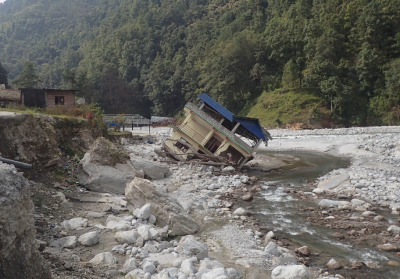Enhancing cooperation to address cascading climate risks in the Hindu Kush Himalaya

Introduction
The Hindu Kush Himalaya (HKH) region faces significant risks from climate change, due to its topography and geography, growing population, and political, financial and development status . Extending from Afghanistan to Myanmar, crossing Pakistan, India, China, Nepal, Bhutan, and Bangladesh, the region is a source of twelve major river systems which provide essential resources to nearly two billion people. The risks generated by climate change pose grave and immediate threats to the people of the HKH and the region’s development, biodiversity, and sustainability.
This brief sets out the rationale for strengthening regional resilience to cascading climate risks in the HKH, illustrating the benefits that cooperation and collaboration can achieve. It also explores what a regional cooperation mechanism could consider and advance in policy and practice, proposing a set of potential areas for collaboration to move the discussions from the realm of ambition to action.
This article is an abridged version of the original text, which can be downloaded from the right-hand column. Please access the original text for more detail, research purposes, full references, or to quote text.
Cascading climate risks for the HKH region
In this brief, we explore three types of risk, broadly based on a geographical approach (while accounting for insights generated by the other approaches), that provide new and additional rationales for regional cooperation on adaptation. These are:
- Intra-regional cascading climate risks: These are risks that both originate within the HKH (due to climate shocks and/or the slow-onset effects of climate change within the region) and also are realised within the HKH, generating consequences for societies, economies, and ecosystems within the region.
- Endogenous cascading climate risks: These are risks that originate within the HKH (due to climate shocks and/or the slow-onset effects of climate change within the region) but manifest or are realised beyond the region, generating consequences for societies, economies, and ecosystems across Asia or the world at large.
- Exogenous cascading climate risks: These are risks that originate beyond the HKH (due to climate shocks and/or the slow-onset effects of climate change around the world) but are realised within the region, generating consequences for societies, economies, and ecosystems within the HKH.
To learn more about the different types of risks and how they can be classified, please refer to pages 2-4 of the original brief.
Key messages
- In a globalised and interconnected world, the impacts of climate change propagate across national borders and pose risks not only to neighbouring countries but also to those on the other side of the world: we call these cascading climate risks.
- Different types of cascading climate risks, including those that originate within the Hindu Kush Himalaya (HKH) and those that originate beyond it, have the potential to severely threaten the region’s societies, economies, and ecosystems.
- Collaboration and cooperation, bringing together state and non-state actors from multiple countries in the region and beyond, are crucial for achieving effective adaptation to cascading climate risks, beyond adaptation at local and national scales.
- Research indicates that regional cooperation on adaptation to climate change in the HKH has the potential to yield multiple benefits: reducing the costs of climate action, helping overcome national- level resource constraints which limit the scale of ambition and action by state and non-state actors, adding credibility to voluntary climate pledges and targets, and enhancing climate diplomacy.
- Around the world, regional cooperation mechanisms for addressing environmental issues encounter various challenges, including a lack of legitimacy and authority to propose mandatory measures, an absence of management structures and governance instruments to achieve high-level goals, and insufficient guidelines on policy implementation.
- We propose the establishment of a regional cooperation mechanism on adaptation to cascading climate risks in the HKH. This mechanism, taking on board lessons from others, could aim to lead and facilitate regional cooperation in four key areas: research, information sharing, and knowledge exchange; cross-scale governance capacity and policy support; climate diplomacy, negotiations, and coalition building; and capacity strengthening, implementation, and finance.

Paddy plants lacking irrigation in Gaur Municipality, Rautahat District, Nepal. (Photo: Jitendra Raj Bajracharya/ICIMOD).
To explore the benefits of cooperation (p.5-6) and existing regional cooperation mechanisms (p.7-8) in more detail please refer to the original brief.
Regional cooperation on adaptation in the HKH in practice
Drawing lessons from cooperation on climate change mitigation and existing examples of cooperation on environmental issues with links to adaptation (from both within and beyond the region), we propose four key areas as the essential pillars of a regional cooperation mechanism on adaptation in the HKH region. These include:
- Research, information sharing, and knowledge exchange – there is still an urgent need for more applied research and accessible datasets to identify key risks (and potential opportunities) for the HKH region, assess how these risks will unfold and endanger the region in future, and develop effective and robust policy solutions that build long-term resilience. Drawing lessons from previous practices, sharing information, and developing joint research projects on cascading climate risks, especially intra- regional cascading climate risks, is the first step in building the necessary knowledge base for cooperation on adaptation in the HKH.
- Cross-scale governance capacity and policy support – lessons drawn from existing examples of regional cooperation frameworks indicate that a lack of governance instruments and coherent policy processes is a key challenge to operationalising cooperation. In the absence of such instruments, the uptake of information and knowledge in adaptation policy- making and planning is also curtailed. Collaborative efforts to update National Adaptation Plans (NAPs) to account for cascading climate risks and cross-scale solutions, as well as integrating them into other relevant policy domains (such as trade, foreign policy, and finance) will be key to building regional resilience.
- Climate diplomacy, negotiations, and coalition building – managing cascading climate risks, especially those transmitting to and from the region (i.e. endogenous and exogenous cascading climate risks), calls for multilateral negotiation and climate diplomacy with countries beyond the HKH. A regional cooperation mechanism could strengthen the unified voice of all member countries and the region as a whole in multilateral processes such as the UNFCCC (e.g., under the global goal on adaptation negotiations) and strengthen the management of cascading climate risks globally.
- Capacity strengthening, implementation, and finance – many of the existing regional frameworks for managing environmental issues set out common goals and objectives but do not advise on necessary institutional structures, operational arrangements, and technical instruments to achieve those objectives, leaving implementation to national and local levels of decision-making. While cooperation to establish high-level goals and commitments is valuable in itself, fragmented and uncoordinated implementation hampers the achievement of those goals and potentially amplifies inequalities within and between countries.
Explore the recommendations in more detail on p. 9-10 of the brief.
Conclusion
As global heating accelerates, cascading climate impacts that both originate from and present risks to the HKH region are becoming an urgent policy priority, deserving of global attention. Aligned with the efforts of other regional organisations (including the European Union and the African Union), the eight countries of the HKH are recognising the gains in resilience that can be achieved from coordinated and strong regional action. Extending these efforts to the domain of adaptation could not be more timely. A regional cooperation mechanism on adaptation to cascading climate risks has the potential to take practical measures of benefit to all member countries and to elevate the voice of the HKH on the global stage – where cascading climate risks are sure to be a defining agenda item of the negotiations on adaptation in the years to come.
Further resources
- Suggested Citation:Talebian, S., Sharma, D., Harris, K., and P. Rana (2023). Enhancing cooperation to address cascading climate risks in the Hindu Kush Himalaya. Adaptation Without Borders Discussion Brief.
- EVENT - Strengthening regional cooperation to address cascading climate risks in the Hindu Kush Himalaya
- How can we fund adaptation efforts to address cascading climate risks in the Hindu Kush Himalaya and other mountain regions?
- The Global Transboundary Climate Risk Report
- Questioning the scientific feasibility and policy relevance of assessing transboundary climate risks
- Glacial lake outburst floods: A shared risk across the Hindu Kush Himalayas

Comments
There is no contentYou must be logged in to reply.